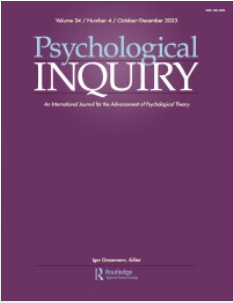在实验室的次优条件下,隐式测量中的偏差作为偏差行为的实例
IF 4.1
2区 心理学
Q1 PSYCHOLOGY, MULTIDISCIPLINARY
引用次数: 2
摘要
Gawronski、Ledgerwood和Eastwick的目标论文(本期)为内隐偏见(IB)文献提供了宝贵的贡献。我们发现自己同意作者提出的许多观点。最重要的是,我们一致认为,重要的是要认识到,内隐测量任务(如内隐关联测试(IAT))的分数在默认情况下不能被解释为无意识偏见的例子。我们也同意,对内隐测量中的偏见的关注可能减缓了IB研究的进展,偏见研究的重点应该是减少现实世界中的偏见,社会差异可能会导致社会歧视,而偏见的心理概念无法捕捉到这种歧视。我们很高兴看到Gawronski等人分享了我们对IB和隐性测量的许多观点(见De Houwer,2006、2014、2019;De Houwer、Teige Mocigenba、Spruyt和Moors,2009年;De Houower、Gawronsky和Barnes Holmes,2013年;De Hoower、Van Dessel和Moran,2021)。最重要的是,(a)IB确实可以被认为是一种行为现象,指的是社会线索对行为的影响,(b)内隐测量与间接测量不同,也不一定反映联想过程。总之,我们支持Gawronski等人在他们的目标论文中提出的大部分内容。尽管如此,我们在某些方面也不同意Gawronski等人(这个问题)的观点。首先,我们仍然认为IB不应局限于无意识的偏见,还应包括以其他方式自动产生的偏见(例如,无意的)。其次,我们继续看到BIM在IB研究中的潜在作用,更具体地说,它是一种教育工具,也是IB在现实世界中的实验室模型。本文章由计算机程序翻译,如有差异,请以英文原文为准。
Bias in Implicit Measures as Instances of Biased Behavior under Suboptimal Conditions in the Laboratory
The target paper of Gawronski, Ledgerwood, and Eastwick (this issue) provides a valuable contribution to the literature on implicit bias (IB). We find ourselves in agreement with many of the points that the authors put forward. Most importantly, we agree that it is important to realize that scores on implicit measurement tasks such as the Implicit Association Test (IAT) cannot by default be interpreted as instances of unconscious bias. We also agree that the focus on bias in implicit measures (BIM) may have slowed progress in research on IB, that the focus of bias research should be on reducing real-world instances of bias, and that societal dispar-ities can result in social discrimination in a way that is not captured by the psychological concept of bias. We are happy to see that Gawronski et al. share many aspects of our perspective on IB and implicit measures (see De Houwer, 2006, 2014, 2019; De Houwer, Teige-Mocigemba, Spruyt, & Moors, 2009, De Houwer, Gawronski, & Barnes-Holmes, 2013; De Houwer, Van Dessel, & Moran, 2021). Most importantly, (a) IB can indeed be conceived of as a behavioral phenomenon that refers to the impact of social cues on behavior, and (b) implicit measures are not the same as indirect measures, nor do they necessarily reflect associative processes. In sum, we support much of what Gawronski et al. put forward in their target paper. Nevertheless, we also disagree with Gawronski et al. (this issue) on some points. First, we continue to believe IB should not be limited to unconscious bias but should include also instances of bias that are automatic in other ways (e.g., unintentional). Second, we continue to see a potential role for BIM in research on IB, more specifically as an educational tool and as a lab model of IB in the real world.
求助全文
通过发布文献求助,成功后即可免费获取论文全文。
去求助
来源期刊

Psychological Inquiry
PSYCHOLOGY, MULTIDISCIPLINARY-
CiteScore
10.30
自引率
1.10%
发文量
31
期刊介绍:
Psychological Inquiry serves as an international journal dedicated to the advancement of psychological theory. Each edition features an extensive target article exploring a controversial or provocative topic, accompanied by peer commentaries and a response from the target author(s). Proposals for target articles must be submitted using the Target Article Proposal Form, and only approved proposals undergo peer review by at least three reviewers. Authors are invited to submit their full articles after the proposal has received approval from the Editor.
 求助内容:
求助内容: 应助结果提醒方式:
应助结果提醒方式:


